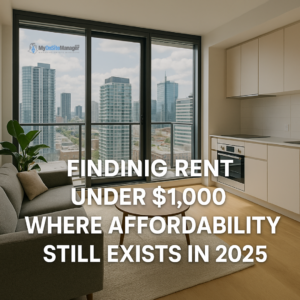In today’s rental market, finding a decent apartment for less than $1,000 a month often feels like an impossible mission. Across many major U.S. cities, median monthly rents have climbed far beyond that figure, putting affordable housing further out of reach for millions of renters.
But not everywhere tells the same story. According to recent data shared by Yahoo, there are still 17 metro areas across the country where the median rent is below $1,000 per month offering a glimpse of hope for renters looking to stretch their budgets further without giving up on housing security.
The Rental Affordability Gap Is Growing
The U.S. rental market has undergone dramatic shifts over the past few years. Economic inflation, supply shortages, rising property taxes, and surging demand have pushed rents upward at an accelerated pace.
For example, in cities like New York, San Francisco, and Los Angeles, median rent for a one-bedroom apartment easily surpasses $2,500 per month. Even traditionally affordable regions have felt the squeeze, with rising costs making it harder for working-class families to keep up.
The new data reveals a stark reality: units below $1,000 are disappearing rapidly. In some states, the decline is staggering. In Washington, the number of apartments priced between $600 and $999 has dropped by more than half over the past decade. In Pennsylvania, affordable rentals have decreased by more than 20%.
These numbers paint a clear picture of a shrinking affordability window for renters across the nation.
Where $1,000 Still Goes Further
So where can renters still find opportunities?
While high-cost coastal metros have priced out most budget-conscious households, smaller cities and less densely populated regions remain relative havens of affordability.
These metro areas often share several characteristics:
-
Lower land and construction costs
-
Slower population growth and less competition for housing
-
Older housing stock with fewer luxury units
-
Lower average wages paired with lower cost of living
These factors help stabilize rental prices, keeping median costs under $1,000. For many households including retirees, remote workers, and first-time renters these areas can offer a more sustainable living option without constant financial strain.
Why Affordable Rentals Are Becoming Rare
Even in these more affordable metros, pressures are mounting that could drive prices higher in the near future.
-
Remote work migration
The shift toward flexible work arrangements has allowed many people to move from expensive cities to lower-cost areas. While good for mobility, this migration has increased competition in affordable markets. -
Shrinking supply
Many older buildings are being upgraded, converted, or torn down to make way for luxury units. These projects reduce the supply of budget rentals and increase the overall market price. -
Rising operating costs
Property owners face higher insurance premiums, maintenance expenses, and taxes costs that often get passed down to renters. -
Regulatory and zoning hurdles
In some regions, restrictive zoning laws slow down new housing construction, further straining the already limited supply.
The combination of these factors means the few affordable pockets left in the U.S. are under increasing pressure and may not stay affordable for long.
Renters Are Adjusting Their Strategies
For those hoping to secure a rental under $1,000, flexibility has become a necessity. Here are a few strategies that many renters are adopting:
-
Looking beyond big cities – Smaller metros or suburban areas often offer lower rent prices without sacrificing too much access to job opportunities or community resources.
-
Acting fast – In high-demand areas, budget-friendly listings are claimed almost immediately after being posted.
-
Compromising on amenities – Affordable rentals may not come with updated finishes, in-unit laundry, or prime locations but can offer long-term stability.
-
Considering shared living – Co-living or renting a room in a shared apartment is becoming increasingly common among young professionals and students.
While these strategies help, they also highlight the underlying issue: the demand for affordable housing is far outpacing supply.
A National Affordability Crisis
The fact that only 17 metro areas still have median rents under $1,000 is a sharp reminder of how uneven the housing market has become.
For many Americans, rent is now the single largest monthly expense. A commonly cited financial rule recommends that housing costs should not exceed 30% of one’s income yet for millions, that figure has climbed far higher, leaving little room for savings or emergencies.
The situation also underscores the need for policy and development solutions, including:
-
Increased investment in affordable housing programs
-
Incentives for builders to create budget-friendly units
-
Smarter zoning laws that allow for higher-density developments
-
Protection for tenants in rapidly changing neighborhoods
Without structural solutions, even these last remaining affordable areas may eventually price out their long-time residents.
Final Thoughts
Affordable rent isn’t entirely gone but it’s becoming a rare find. For renters willing to explore new locations and accept trade-offs, these 17 metro areas present real opportunities to live within their means.
But the big picture is harder to ignore: rising costs and shrinking affordable inventory make it clear that the U.S. housing market faces deep affordability challenges. Without bold action, the places where rent is under $1,000 may soon disappear altogether.
Source: Yahoo – “Rent for less than $1,000 a month? You can find it in these …”

